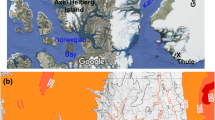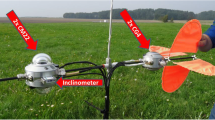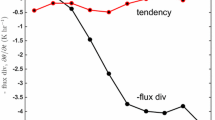Abstract
We apply well-established flux–gradient relationships to deduce the aerodynamic and radiative properties of a winter wheat crop, using a neglected 1971 dataset (hourly averages), only recently resurrected as part of a historical review of precision CO2 measurements in Australia (Pearman et al. in Hist Rec Aust Sci 28:111–125, 2017). The aerodynamic roughness length (seasonal variation between 0.07 and 0.14 of the mean crop height) and broadband albedo (seasonal variation between 0.13 and 0.23) are consistent with values published in the literature over the past 50 years. Net radiation at night is found to agree with the net longwave flux only when the dry-bulb temperature exceeds 10 °C, probably the result of dewfall on one or both of the two instruments. During the day, the sum of the four individual radiative flux components (upwards and downwards shortwave and longwave)—the composite net radiation—exceeds the directly measured net radiation, from near zero at sunrise to approximately 100 W m−2 at maximum net radiation ≈ 600 W m−2, viz. an underestimate in the directly measured net radiation of close to 15%. Again, this is in line with instrument comparisons made in the USA and Europe 15–25 years ago. A novel approach is used in the analysis of terms in the surface energy budget, viz., normalization of all terms by the downwelling shortwave flux. Normalization reveals, (1) near-normal frequency distributions of both the total turbulent heat flux (sensible plus latent) and the implied total storage (the residual); (2) significant diurnal variations in the total turbulent heat flux, whose standard deviations of individual values about any hourly mean during daytime are reduced significantly on those for either the sensible or latent heat flux; (3) an implied storage term with a well-defined diurnal variation, but with an overall mean value of 1% of the shortwave input. Overall, with the above results in mind, the computed momentum and heat fluxes (and also the CO2 flux) during the daytime, at small to moderate gradient Richardson numbers, provide support for the profile approach when eddy-correlation fluxes are unavailable. Even so, possible errors due to, (1) uncertainties in the zero-plane displacement, and (2) influences of the roughness sublayer, must be borne in mind.












Similar content being viewed by others
Notes
The treatment by Harman and Finnigan (2007; Sects. 3.2 and 3.3) is useful here since they describe analytically how the general wind profile (in a normalized gradient form) between the canopy and levels within the inertial subrange can be treated as the product of functions, where the specified functions represent the individual influences of buoyancy and roughness sublayer mixing on the profile. Integration from the surface to some height z is accordingly justified, as can be readily demonstrated in the neutral case. This yields a sum of functions in integrated form, where each again represents the individual influences of buoyancy and roughness sublayer mixing on the profile.
First ISLSCP Field Experiment—in other words, a double acronym requiring no further comment.
The matter of density fluctuations was addressed, inter alia, by A.J. Dyer in the 1960s, but was considered inconsequential for H and λE quantification. The extension in the 1970s of eddy correlation to the fluxes of trace gases SO2, O3, and later CO2 required its consideration, and was dealt with as applications required. So far as instrumental issues were concerned, both C.J. Moore and J.M. Wilczak were involved in early work at the CSIRO Aspendale (Moore) and Argonne National (Wilczak) Laboratories in the 1970s and 1980s, whilst M.L. Wesely in a 1970 Ph.D. thesis reported on early investigations into coordinate issues while at the University of Wisconsin [B.B. Hicks, 2020; priv. comm.].
References
Baldocchi D (1994) A comparative study of mass and energy exchange rates over a closed C3 (wheat) and an open C4 (corn) crop: II. CO2 exchange and water use efficiency. Agric For Meteorol 67:291–321
Brutsaert W (1982) Evaporation into the Atmosphere. Reidel, Dordrecht
Businger JA, Wyngaard JC, Izumi Y, Bradley EF (1971) Flux-profile relationships in the atmospheric surface layer. J Atmos Sci 28:181–189
Denmead OT (1969) Comparative micrometeorology of a wheat field and a forest of Pinus radiata. Agric Meteorol 6:357–371
Denmead OT, McIlroy IC (1961) Measurement of carbon dioxide exchange in the field. In: Sestak Z, Catsky J (eds) Plant photosynthetic manual of methods. W. Junk, Pubs, The Hague, pp 467–516
Dunin FX, Meyer WS, Wong SC, Reyenga W (1989) Seasonal change in water use and carbon assimilation of irrigated wheat. Agric For Meteorol 45:231–250
Dyer AJ (1974) A review of flux-profile relationships. Boundary-Layer Meteorol 7:363–372
Field RT, Fritschen LJ, Kanemasu ET, Smith EA, Stewart JB, Verma SB, Kustas WP (1992) Calibration, comparison, and correction of net radiation instruments used during FIFE. J Geophys Res 97(D17):18681–18695
Finnigan JJ (2004) A re-evaluation of long-term flux measurement techniques Part II: coordinate systems. Boundary-Layer Meteorol 113:1–41
Foken T (2008) The energy balance closure problem: an overview. Ecol Appl 18(6):1351–1367
Garratt JR (1992) The atmospheric boundary layer. Cambridge University Press, Cambridge
Garratt JR, Hicks BB (1973) Momentum, heat and water vapour transfer to and from natural and artificial surfaces. Q J R Meteorol Soc 99:680–687
Garratt JR, Hicks BB (1990) Micrometeorological and PBL experiments in Australia. Boundary-Layer Meteorol 50:11–29
Graf A, van de Boer A, Moene A, Vereecken H (2014) Intercomparison of methods for the simultaneous estimation of zero-plane displacement and aerodynamic roughness length from single-level eddy-covariance data. Boundary-Layer Meteorol 151:373–387
Hagishima A, Tanimoto J, Nagayama K, Meno S (2009) Aerodynamic parameters of regular arrays of rectangular blocks with various geometries. Boundary-Layer Meteorol 132:315–337
Halldin S, Lindroth A (1992) Errors in net radiometry: comparison and evaluation of six radiometer designs. J Atmos Ocean Technol 9:762–782
Halliwell DH, Rouse WK (1989) A comparison of sensible and latent heat flux calculations using the Bowen ratio and aerodynamic methods. J Atmos Ocean Technol 6:563–574
Harman IN, Finnigan JJ (2007) A simple unified theory for flow in the canopy and roughness sublayer. Boundary-Layer Meteorol 123:339–363
Harman IN, Finnigan JJ (2008) Scalar concentration profiles in the canopy and roughness sublayer. Boundary-Layer Meteorol 129:323–351
Hicks BB, Baldocchi D (2020) Measurements of fluxes over land—capabilities, origins, and remaining challenges. Boundary-Layer Meteorol (this issue)
Hicks BB, Eash NS, O’Dell DL, Oetting JN (2020) Augmented Bowen ratio analysis—I. Site adequacy, fetch, and heat storage. Agric For Meteorol (in press)
Jacobs AFG, van Boxel JH (1988) Computational parameter estimation for a maize crop. Boundary-Layer Meteorol 42:265–279
Kang L, Zhang J, Zou X, Cheng H, Zhang C, Yang Z (2019) Experimental investigation of the aerodynamic roughness length for flexible plants. Boundary-Layer Meteorol 172:397–416
Kohsiek W, Liebethal C, Foken T, Vogt R, Oncley SP, Bernhofer Ch, Debruin HAR (2007) The energy balance experiment EBEX-2000. Part III: behaviour and quality of radiation measurements. Boundary-Layer Meteorol 123:55–75
Massman W (1997) An analytical one-dimensional model of momentum transfer by vegetation of arbitrary structure. Boundary-Layer Meteorol 83:407–421
Meyers TP, Hollinger SE (2004) An assessment of storage terms in the surface energy balance of maize and soybean. Agric For Meteorol 125:105–115
Moore CJ (1986) Frequency response corrections for eddy correlation systems. Boundary-Layer Meteorol 37:17–35
Paltridge GW (1969) A net longwave radiometer. Q J R Meteorol Soc 95:635–638
Paltridge GW (1970) A model of a growing pasture. Agric Meteorol 7:93–130
Paltridge GW, Dilley AC, Garratt JR, Pearman GI, Shepherd W, Connor DJ (1972) The Rutherglen experiment on Sherpa wheat: environmental and biological data. CSIRO Div Atmos Phys Tech Paper No.22
Pearman GI, Garratt JR (1973) Carbon dioxide measurements above a wheat crop. I. Observations of vertical gradients and concentrations. Agric Meteorol 12:13–25
Pearman GI, Garratt JR, Fraser PJ (2017) CSIRO high precision measurements of atmospheric CO2 concentration in Australia. Part 1: initial motivation, techniques and aircraft sampling. Hist Rec Aust Sci 28:111–125
Raupach MR (1992) Drag and drag partition on rough surfaces. Boundary-Layer Meteorol 60:375–395
Raupach MR (1994) Simplified expressions for vegetation roughness length and zero-plane displacement as functions of canopy height and area index. Boundary-Layer Meteorol 71:211–216
Sinclair TR, Murphy CE, Knoerr KR (1976) Development and evaluation of simplified models for simulating canopy photosynthesis and transpiration. J Appl Ecol 13:813–829
Stearns CR (1970) Conversion of profile difference quotients to true gradients at the geometric mean height in the surface layer. Boundary-Layer Meteorol 1:146–154
Swinbank WC, Dyer AJ (1967) An experimental study in micrometeorology. Q J R Meteorol Soc 93:494–500
Theeuwes NE, Ronda RJ, Harman IN, Christen A, Grimmond SB (2019) Parametrizing horizontally-averaged wind and temperature profiles in the urban roughness sublayer. Boundary-Layer Meteorol 173:312–348
Webb EK (1970) Profile relationships: the log-linear range and extension to strong stability. Q J R Meteorol Soc 96:67–90
Webb EK, Pearman GI, Leuning R (1980) Correction of flux measurements for density effects due to heat and water vapour transfer. Q J R Meteorol Soc 106:85–100
Wilczak JM, Oncley SP, Stage SA (2001) Sonic anemometer tilt correction algorithms. Boundary-Layer Meteorol 99:127–150
Acknowledgements
We thank former staff at CSIRO who maintained and operated the Rutherglen site in 1971 (Geoff Richards (deceased) and Jim O’Toole in particular), and to those who produced the data tapes many years ago. Thanks also to Nada Derek of CSIRO who produced the figures and to Bruce Hicks who made us aware of significant historical issues related to flux measurement. J.R. Garratt acknowledges his CSIRO honorary fellowship.
Author information
Authors and Affiliations
Corresponding author
Additional information
Publisher's Note
Springer Nature remains neutral with regard to jurisdictional claims in published maps and institutional affiliations.
Appendices
Appendix 1
We take the following flux–gradient relations valid for steady-state and horizontally homogeneous conditions (e.g., Garratt 1992; Chap. 3),
where Km and Kh are eddy transfer coefficients for momentum, and for the scalars Ѳ (heat), q (water vapour) and c (the \( {\text{CO}}_{2} \) concentration or mass mixing ratio). In the above, u∗ is the friction velocity, H is the sensible heat flux, E is the evaporation rate (\( \lambda E \) being the latent heat flux), and Fc is the vertical \( {\text{CO}}_{2} \) flux. Non-dimensional forms of the vertical gradients in the inertial sublayer, and based on Monin–Obukhov similarity theory, are consistent with taking,
and
where k is the von Kármán constant, \( \varphi_{c } {\text{and}} \varphi_{m} \) are stability functions, and L is the Obukhov length. Combining the above gives
whence,
From these three last equations, we can write
Note that the integral form of Eq. 19 or 23 produces the logarithmic wind profile in neutral conditions, with Eq. 5 in the main text being the general integral form. Equations 23–26 form the basis of the micrometeorological method common in the 1970s before eddy correlation became widely available. Then, and in the present article, we use the finite difference form since vertical differences of wind speed, dry-bulb, and wet-bulb temperatures between 1 and 2 m above the crop are the relevant measured quantities. Hence, the fluxes are based on
for a height increment \( \Delta z \), mean height \( \bar{z}, \) and for which Eqs. 1–3 in the main text are the abbreviated forms. The mean height \( \bar{z} \) is taken as the geometric mean height between the two selected levels, viz. \( \bar{z} = \left( {z_{1} z_{2} } \right)^{0.5} \). The \( \varphi_{h } {\text{and}} \varphi_{m} \) functions can be expressed in terms of the gradient virtual Richardson number Ri (e.g. see Garratt 1992, Chapter 3),
where the numerical factor 0.033 is simply g/θ, g is the acceleration due to gravity, and θ is the mean virtual potential temperature. With Ri evaluated using \( \Delta u, \Delta \theta \), and \( \Delta q, \) these well-known empirical stability functions can be readily calculated.
Thus, using the well-known relations for Ri < 0, z/L = Ri and for Ri > 0, z/L = Ri/(1 − 5 Ri), then
for, say, −0.5 < Ri < 0, and
for, say, Ri < 0.1. One arm of modern thinking (e.g., B.B. Hicks, priv. comm. 2020) argues that Monin–Obukhov similarity theory, through the flux–gradient relations given above and used herein, is only reliable (and valid) in near-neutral conditions, defined by a rather small range of Ri. The argument goes that the turbulent transfer process is modified swiftly by convective eddies as Ri becomes more negative, and is affected significantly by intermittency as Ri becomes more positive, situations for which the flux–gradient relation is a gross simplification. A second arm of modern thinking accepts the deficiencies in the flux–gradient representation of turbulent transfer, and offers this as the basis of a rigorous description of turbulent flow and its transfer properties in the roughness and inertial sublayers above an aerodynamically rough canopy (e.g., Harman and Finnigan 2007, 2008; Theeuwes et al. 2019). Even so, the theory and its application is often limited to neutral and stratified flows with, typically, − 1 < Ri < 0.1. Indeed the widespread use of Monin–Obukhov similarity theory (and hence implicitly a flux–gradient assumption, at least in part) in numerical models of the atmosphere, including numerical weather prediction, climate modelling, and large-eddy simulation, is to be noted. With few other practical options available, we have limited the use of Monin–Obukhov similarity theory in our analysis to a relatively narrow range in Ri around near-neutral conditions.
Appendix 2
We give below measured and derived quantities for most daytime hours on a sample day: day 139 (26 September 1971); crop height = 0.7 m. All measurements at hourly intervals (mostly 1-h averages) are available in Paltridge et al. (1972), which can be accessed online. For easy conversion below note that, at 15 °C, an evaporation rate of 1 mm d−1 is equivalent to a latent heat flux of 28.6 W m−2.
0800 | 0900 | 1000 | 1100 | 1200 | 1300 | 1400 | 1500 | 1600 | |
|---|---|---|---|---|---|---|---|---|---|
MEASURED | |||||||||
Wind direction | 320 | 300 | 310 | 310 | 300 | 270 | 270 | 270 | 270 |
\( T_{a} \) (°C) | 8.0 | 9.4 | 10.6 | 11.1 | 12.5 | 13.1 | 13.7 | 14.0 | 14.3 |
ΔT (K) | − 0.06 | − 0.17 | − 0.19 | − 0.09 | − 0.16 | − 0.06 | 0.08 | 0.16 | 0.22 |
\( \Delta T_{w} \) (K) | − 0.17 | − 0.28 | − 0.34 | − 0.29 | − 0.38 | − 0.35 | − 0.27 | − 0.24 | − 0.17 |
\( u_{1} \) (m s−1) | 2.28 | 3.48 | 3.51 | 3.37 | 3.98 | 4.03 | 5.01 | 4.01 | 4.68 |
\( u_{2} \) (m s−1) | 2.72 | 4.15 | 4.16 | 4.01 | 4.72 | 4.79 | 5.96 | 4.80 | 5.60 |
ΔC (ppm) | 1.1 | 1.5 | 1.9 | 2.2 | 2.0 | 1.9 | 1.6 | 1.5 | 1.0 |
\( E_{lys} \) (mm \( {\text{d}}^{ - 1} \)) | 3.1 | 6.1 | 7.9 | 7.0 | 11.3 | 14.6 | 13.4 | 10.4 | 10.4 |
\( S_{soil} \) (W m−2) | − 8 | − 1 | 5 | 6 | 11 | 11 | 8 | 5 | 2 |
\( R_{n} \) (W m−2) | 78 | 240 | 288 | 227 | 377 | 338 | 280 | 212 | 141 |
\( S_{ \downarrow } \) (W m−2) | 259 | 445 | 521 | 395 | 653 | 585 | 486 | 380 | 289 |
\( S_{ \uparrow } \) (W m−2) | 72 | 116 | 127 | 98 | 152 | 140 | 119 | 94 | 71 |
ΔL (W m−2) | − 59 | − 35 | − 33 | − 25 | − 43 | − 43 | − 35 | − 41 | − 43 |
DERIVED | |||||||||
Δq \( times 10^{3} \) | − 0.13 | − 0.19 | − 0.24 | − 0.24 | − 0.32 | − 0.34 | − 0.32 | − 0.32 | − 0.27 |
Ri | − 0.013 | − 0.014 | − 0.018 | − 0.010 | − 0.012 | − 0.006 | 0.001 | 0.006 | 0.007 |
u∗ (m s−1) | 0.45 | 0.44 | 0.50 | 0.50 | 0.61 | 0.49 | 0.58 | ||
H (W \( {\text{m}}^{ - 2} \)) | 15 | 66 | 75 | 30 | 66 | 21 | − 45 | − 66 | − 103 |
\( \lambda E \) (W \( {\text{m}}^{ - 2} \)) | 86 | 194 | 243 | 229 | 350 | 361 | 393 | 308 | 301 |
\( F_{c} \) x \( 10^{7} \) *** | − 5 | − 10 | − 11 | − 12 | − 13 | − 12 | − 12 | − 8 | − 7 |
Rights and permissions
About this article
Cite this article
Garratt, J.R., Pearman, G.I. Retrospective Analysis of Micrometeorological Observations Above an Australian Wheat Crop. Boundary-Layer Meteorol 177, 613–641 (2020). https://doi.org/10.1007/s10546-020-00526-9
Received:
Accepted:
Published:
Issue Date:
DOI: https://doi.org/10.1007/s10546-020-00526-9




